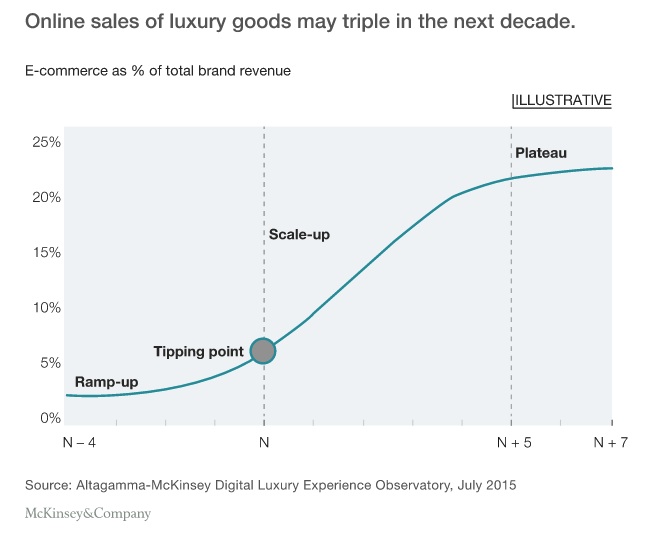Is luxury brand eCommerce at a tipping point?
Though much of shopping is still taking place in bricks and mortar stores, consumers are spending a substantial amount of time exploring and researching online. Luxury brand eCommerce websites continue to be important point of interaction for luxury shoppers.
While Business Insider reported that luxury shopping is becoming ‘less brand- and status-oriented’ as millennials age, McKinsey & Company thinks that luxury eCommerce is coming close to its tipping point. By 2025, ‘online sales of luxury goods could triple to €70 billion’ before hitting a plateau.

(Image via)
Having analysed the online-sales trajectories of over fifty high-end brands over the past 10 years, the report found that eCommerce store is now a ‘top management priority’ as a result of the remarkable investments needed for IT, customer support and the supply chain.
Building a premium eCommerce experience
If that is the case, more brands will need to be prepared for the ‘tipping point’ to create the exclusive and slick online experience that exceeds customer expectations and amplifies potential sales. That means more brands will need to look beyond pixels. According to Digiday, there are three particularly important factors that digitally-savvy luxury brands prioritise: content, personalisation and customer service.
Content
Content, needless to say, has always been the backbone of successful luxury eCommerce business. Since eCommerce has become more than just a product listing, content is what makes an eCommerce site unique from another. With regard to luxury fashion, content is often used to exploit their fascinating stories surrounding heritage and craftsmanship (which is also used to justify their premium price point). From videos to editorials, many luxury brands like Burberry and Hermès offer digital contents that cannot be found inside bricks and mortar stores. Great content also helps maintain a thriving community of brand loyalists, says Ometria. Brands such as Chanel used image-oriented microsites to enrich its brand story.
Personalised experience
When moving from offline to online, a touch of personalisation often gets compromised. But tech-savvy luxury brands are well aware that personalised offers and services determine healthy relationship with their customers. So how do brands provide personalisation online? Top brands utilise the flexibility of an eCommerce site. According to Digiday: ‘at Hermès, when an item is added to a cart, more question fields pop: the preferred method of delivery and location. The site will then show more options for the customer, and remember the customer’s preferences and location.’ Similarly, Burberry launched ‘design your own scarf’ option on its website prior last winter. Shoppers were able to customise the colour, size and a monogram at ease, just like in Burberry flagship stores.
Customer service
Again from Digiday, ‘a superior experience online, for luxury retailers, means seamless customer service’. Excellent customer service includes free shipping, free returns, live chat functions and so on. But it is also about excellent user experience that enables shoppers to find the key information (such as terms and conditions) immediately. Luxury eCommerce sites need to provide shoppers with easy ways to access and contact the customer center. Excellent customer service and support extends beyond eCommerce site to social media where fans expect brands to respond to their complaints and so on.
A more integrated and coherent multi-channel strategy
Besides those three key functionalities, however, only a few leading luxury labels are embracing the multi-channel digital experience. Nowadays, it is a combination of multiple communication channels, from eCommerce to email and social media, that customers use to interact with brands. And brands must be present at everywhere their potential customers are.
For example, Christian Louboutin employed an elaborate multi-channel marketing campaign to unfold a branded story. They began by teasing on social media which then encouraged viewers to visit the website, hoping that they will eventually visit the stores to try the new collections out. According to SAS, ‘multichannel customers spend three to four times more than single-channel customers do’. Many top brands use a highly orchestrated multichannel strategies to engage customers across a wide range of touchpoints and deliver their micro-campaigns that span across various digital platforms. By doing so, brands could maximise their digital outreach in the face of declining organic reach. Luxury eCommerce is highly integral to a brand’s multi-channel communication strategy: while it is important to build a seamlessly eCommerce site, truly tech-savvy ones also distribute their efforts and budgets on driving traffic across varied communication channels.








0.Comments